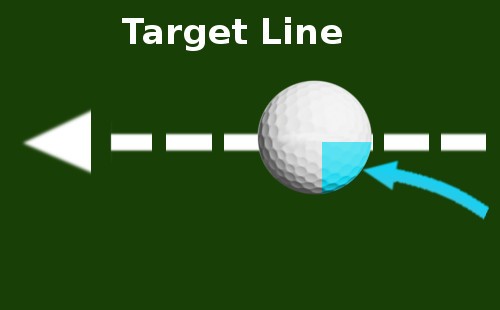5 steps to hit a high draw golf shot:
- Set up with a slightly closed stance. This means that your left foot should be slightly farther back than your right foot.

- Grip the club with a strong grip. This means that your hands should be rotated slightly to the right, so that the clubface is pointing slightly more to the right of your target.
- Take a backswing that is slightly inside-out. This means that you should start your backswing by moving the clubhead slightly to the left of your target, and then bring it back in towards your body.
- Swing down on the ball with a slight upward angle of attack. This will help to create a steeper angle of descent, which will cause the ball to fly higher.
- Follow through with your swing. Make sure to finish your swing with your arms extended and your weight shifted to your front foot.
Here are some additional tips for hitting a high draw golf shot: 
- Use a club with a draw bias. This means that the clubface is designed to produce a slight draw.
- Hit the ball on the upswing. This will help to create a steeper angle of ascent, which will also cause the ball to fly higher.
- Practice regularly. The more you practice, the better you will become at hitting a high draw golf shot.
Here are some common mistakes to avoid when hitting a high draw golf shot:
- Setting up with an open stance. This will cause the ball to start out to the right and then curve even further to the right.
- Using a weak grip. This will cause the clubface to open at impact, which will also cause the ball to start out to the right.
- Taking a backswing that is too outside-in. This will cause the clubhead to come from too far to the left, which will make it difficult to hit a draw.
- Swinging down on the ball with a downward angle of attack. This will cause the ball to fly lower.
- Not following through with your swing. This will cause the clubhead to lose momentum, which will also make it difficult to hit a draw.
Update:
Hitting a high draw golf shot is a skill that many golfers aim to develop. Here are five steps to help you achieve this shot:
- Grip Setup:
- Ensure you have a neutral grip on the club. A strong grip (both hands turned to the right for a right-handed golfer) can help promote a draw.
- Align your feet, hips, and shoulders slightly to the right of your target (for right-handed golfers). This closed stance helps set up the draw.
- Ball Position:
- Place the golf ball slightly farther back in your stance than you would for a straight shot. This encourages an inside-out swing path and better contact with the ball.
- Swing Path:
- To hit a draw, you need an inside-out swing path. Imagine swinging from the inside of the target line to the outside after impact.
- Focus on a smooth takeaway and transition, keeping the clubhead inside your hands during the backswing.
- Clubface Alignment:
- Aim the clubface slightly right of your target at address. This open clubface combined with the closed stance helps create the desired draw spin.
- Release and Follow-Through:
- As you start your downswing, focus on rotating your hips and initiating your downswing with your lower body.
- As you approach impact, feel your hands releasing the clubhead, allowing it to catch up with your body.
- A key element in hitting a high draw is a strong and high finish. This helps impart the upward launch and spin needed for the shot.
Q&A:
Q: What is a high draw golf shot? A: A high draw golf shot is a shot that curves from right to left (for right-handed golfers) while maintaining a higher trajectory. It combines a controlled draw spin with a higher launch angle.
Q: Why would I want to hit a high draw golf shot? A: Hitting a high draw can be advantageous in certain situations. It allows you to carry obstacles, like trees or hazards, and stop the ball quickly on the green due to the added backspin.
Q: How do I set up for a high draw shot? A: Start with a slightly closed stance, which means your feet, hips, and shoulders are aligned a bit to the right of the target (for right-handed golfers). This setup promotes the desired draw spin.
Q: Where should I position the ball in my stance for a high draw shot? A: Place the ball slightly farther back in your stance than you would for a straight shot. This helps you make contact with the ball after your clubface has started closing, promoting the draw.
Q: What is the key to creating the draw spin? A: The key is to have an inside-out swing path. This means your clubhead approaches the ball from the inside of the target line, then moves outward. This creates sidespin that produces the draw.
Q: How do I ensure a high trajectory for the shot? A: Focus on hitting up on the ball slightly at impact. This promotes a higher launch angle. A good finish with your weight on your front foot also helps achieve the desired trajectory.
Q: What about clubface alignment? A: At address, aim the clubface slightly right of your target. This open clubface, when combined with the closed stance, encourages the ball to start right and then curve back left.
Q: How do I release the club properly for a high draw? A: Focus on rotating your hips and initiating your downswing with your lower body. As you approach impact, allow your hands to release the clubhead. A strong and high finish is crucial.
Q: What clubs are best for hitting a high draw? A: Generally, your longer clubs like drivers and fairway woods are suitable for hitting a high draw due to their loft and design.
Q: Can I control the amount of draw spin? A: Yes, you can adjust the amount of draw by experimenting with your setup, grip, and swing path. A more closed stance and stronger grip may result in a bigger draw.
Remember, hitting a high draw requires practice and experimentation to find what works best for you. It's recommended to work with a golf instructor to refine your technique and receive personalized guidance based on your swing characteristics.
Benefits To Hitting a High Draw Golf Shot:
Hitting a high draw golf shot, where the ball starts to the right of the target (for right-handed golfers) and curves gently from right to left, offers several benefits for golfers, especially when executed intentionally and accurately. Here are some of the key advantages:
- Increased Distance: A well-executed high draw can result in added distance compared to a straight or fade shot. This is because the draw imparts extra backspin on the ball, helping it stay in the air longer and carry farther.
- Optimal Trajectory: A high draw typically flies on a slightly higher trajectory than a fade or slice. This can be advantageous when trying to carry hazards, trees, or other obstacles on the golf course.
- Controlled Curve: Unlike a hook (exaggerated draw) or a slice (left-to-right curve for right-handed golfers), a high draw provides a controlled curve. It allows golfers to shape their shots around obstacles and hold greens with more precision.
- Wind Performance: A high draw can be more wind-resistant than a fade or a straight shot. The right-to-left curvature can help counteract the effects of crosswinds, making it a useful shot in windy conditions.
- Greenside Control: On approach shots to the green, a high draw can lead to softer landings and better control over spin. This can result in shots that stop quickly on the green, helping golfers get closer to the pin.
- Versatility: Learning to hit a high draw adds versatility to a golfer's repertoire. It allows them to adapt to various course conditions and shot requirements.
- Increased Rollout: On the fairway or in the rough, a high draw shot can generate additional rollout after landing. This can be beneficial when looking to maximize distance off the tee or reach a distant pin on an approach shot.
- Confidence and Strategy: Golfers who can confidently execute a high draw often have a better strategic advantage on the course. They can plan their shots to take advantage of the draw's controlled curve.
- Reduced Sidespin: A well-executed high draw typically has less sidespin than a hook or slice. This reduced sidespin can result in straighter, more predictable ball flight.
- Enhanced Shot Shaping: Golfers who can shape their shots with a high draw have a valuable skill for navigating challenging course layouts, doglegs, and other course features.
It's important to note that hitting a high draw consistently can be challenging and requires practice and skill development. Not every golfer will naturally have this shot in their arsenal, but those who can use it effectively can gain a significant advantage in certain situations on the golf course.






